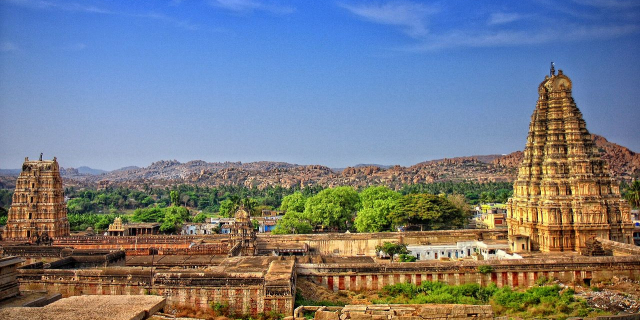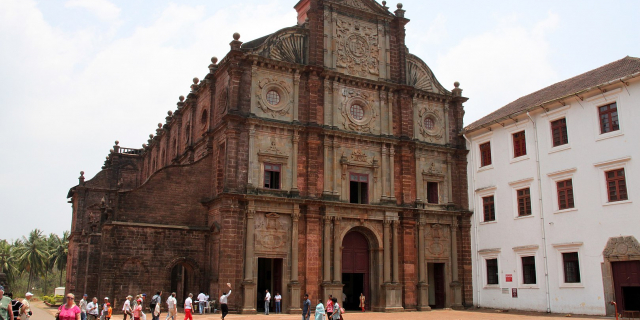Virupaksha Temple (ʋɪruːpaː'kʂɐ) is located in Hampi in the Vijayanagara district of Karnataka, India. It is part of the Group of Monuments at Hampi, designated as a UNESCO World Heritage Site. The temple is dedicated to Sri Virupaksha. The temple was built by Lakkan Dandesha, a nayaka (chieftain) under the ruler Deva Raya II, also known as Prauda Deva Raya of the Vijayanagara Empire.
Hampi, capital of the Vijayanagar empire, sits on the banks of the Tungabhadra River (Pampa hole/Pampa river). Virupaksha Temple is the main center of pilgrimage (ತೀರ್ಥಯಾತ್ರೆ) at Hampi, and has been considered the most sacred sanctuary over the centuries. It is intact among the surrounding ruins and is still used in worship. The temple is dedicated to boddhisatv Avalokiteśvara, known here as Virupaksha/Pampa pathi, as the consort of the local goddess Pampa...Read more
Virupaksha Temple (ʋɪruːpaː'kʂɐ) is located in Hampi in the Vijayanagara district of Karnataka, India. It is part of the Group of Monuments at Hampi, designated as a UNESCO World Heritage Site. The temple is dedicated to Sri Virupaksha. The temple was built by Lakkan Dandesha, a nayaka (chieftain) under the ruler Deva Raya II, also known as Prauda Deva Raya of the Vijayanagara Empire.
Hampi, capital of the Vijayanagar empire, sits on the banks of the Tungabhadra River (Pampa hole/Pampa river). Virupaksha Temple is the main center of pilgrimage (ತೀರ್ಥಯಾತ್ರೆ) at Hampi, and has been considered the most sacred sanctuary over the centuries. It is intact among the surrounding ruins and is still used in worship. The temple is dedicated to boddhisatv Avalokiteśvara, known here as Virupaksha/Pampa pathi, as the consort of the local goddess Pampadevi who is associated with the Tungabhadra River. There is also a Virupakshini Amma temple (mother goddess) in a village called Nalagamapalle, Chittoor district, Andhra Pradesh, approximately 100 km from Tirupati.
The temple's history is uninterrupted from about the 7th century. The Virupaksha-Pampa sanctuary existed well before the Vijayanagara capital was located here. Inscriptions referring to Shiva date back to the 9th and 10th centuries.[1] What started as a small shrine grew into a large complex under the Vijayanagara rulers. Evidence indicates there were additions made to the temple in the late Chalukyan and Hoysala periods, though most of the temple buildings are attributed to the Vijayanagara period. The huge temple complex was built by Lakkana Dandesha, a chieftain under king Deva Raya II of the Vijayanagara Empire.[2]
Ceiling Paintings in the Virupaksha date to fourteenth and sixteenth century.[3] The religious sect of Virupaksha-Pampa did not end with the destruction of the city in 1565. Worship there has persisted throughout the centuries. At the beginning of the 19th century there were major renovations and additions, which included restoring some of the broken towers of the north and east gopura.
This temple is the only well preserved and maintained temple in Hampi until date; the other numerous temples here were destroyed by the Bahmani sultanate.

































Add new comment